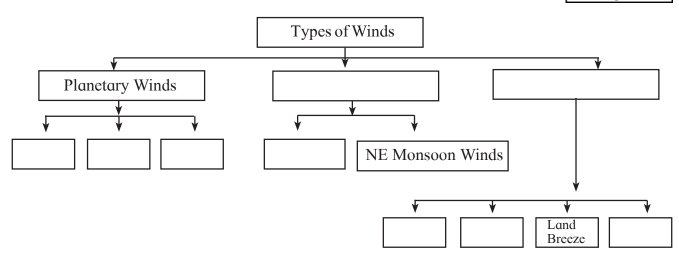Winds
Maharashtra Board-Class-7th-Geography-Chapter-5
Solutions
Question-1
Rewrite the following statements after choosing the correct option.
(1) When the air expands, it .............. .
(a) becomes solid
(b) becomes thinner
(c) gets lost
(d) becomes humid
When the air expands, it becomes thinner
(2) From high air pressure regions, winds ............ .
(a) blow to regions of still higher pressure.
(b) blow towards regions of cooler air.
(c) blow towards regions of low air pressure.
(d) remain still.
From high air pressure regions, winds blow towards regions of low air pressure.
(3) In the northern hemisphere, winds blowing towards the equator .......... due to the rotation of the earth.
(a) turn to the south
(b) turn to the east
(c) turn to the west
(d) turn to the north
In the northern hemisphere, winds blowing towards the equator turn to the west due to the rotation of the earth.
(4) The direction of seasonal winds blowing over the Indian subcontinent during winter is from the ....... .
(a) south-east to north-west.
(b) south-west towards north-east.
(c) north-east to south-west.
(d) north-west to south-east.
The direction of seasonal winds blowing over the Indian subcontinent during winter is from the north-east to south-west.
(5) The Roaring Forties in the southern hemisphere
(a) blow towards the equator.
(b) blow in the areas around 40° S parallel.
(c) blow from the subpolar region of low pressure.
(d) blow around 40° N parallel.
The Roaring Forties in the southern hemisphere blow in the areas around 40° S parallel.
Question-2
Identify the type of winds from the description given below.
(1) These winds from the south-west bring rains to the Indian subcontinent. During June to September, India gets rains. After this period these winds retreat.
These winds are Southwest monsoon winds.
(2) These winds blowing from the north pole region towards 60° N parallel cause cold wave conditions in extensive areas covering North America, Europe and Russia.
These winds are Polar winds
(3) Hilltops get heated quickly during the day. The air in this part becomes hot, light and starts ascending. Hence, a low pressure area forms in this region. At the same time the air at the foothills being cooler, and that area experiences high pressure. Air in that area blows towards low pressure.
These winds are Valley breeze.
Question-3
Given below are the values of air pressure in millibars. Using the same, draw diagrams to show a cyclone and an anticyclone.
(i) 990, 994, 996, 1000 (ii) 1030, 1020, 1010, 1000

Question-4
State one reason why.
(1) A belt of calm exists near the equator.
Therefore, a belt of calm exists near the equator.
(2) The winds coming from the north-west in the southern hemisphere have greater velocities than the winds coming from the south-west in the northern hemisphere.
(3) The monsoon winds in the summer come from the sea but the retreating monsoon winds in winter come from land.
Monsoon winds are generated due to the uneven heating of land and water in the different seasons.
Question-5
Complete the flow chart:


Question-6
Answer in short:
(1) Why is the air pressure high in polar areas in both the hemispheres?
(2) What effect does the rotation of the earth have on the winds?
(3) Why do the cyclonic winds blow in a circular manner?
Therefore, the cyclonic winds blow in a circular manner.
(4) State the reasons that lead to the formation of cyclones and describe the effects of cyclones.
Reasons that lead to the formation of cyclones : Effects of cyclones :
Click on below link to get PDF from store
MSBSHSE-Class-7-Geography-Chapter-5-Winds-Notes
MSBSHSE-Class-7-Geography-Chapter-5-Winds-Solutions
MSBSHSE-Class-7-Geography-Chapter-5-Winds-Book
All Chapter Class-7-Geography Notes Set (11-PDF) Rs. 35-Buy
All Chapter Class-7-Geogarphy Solutions Set (10-PDF) Rs. 28-Buy
All Chapter Class-7-Geogarphy Notes + Solutions Set (21-PDF) Rs. 55-Buy
All Notes -Social Science (History_Civic+Geography-30-PDF) Rs. 80-Buy
All Solutions -Social Science (History_Civic+Geography-29-PDF) Rs. 72-Buy
All Notes + Solutions -Social Science (History_Civic+Geography-59-PDF) Rs. 135-Buy
Useful links for Class 7
| Main Page : Class 7th MSBSHSE – Geography - All chapters notes, solutions, videos, test, pdf.
Books : Maharashtra Board-Class 7th Geography Text Books – Chapter wise PDF for download Previous Chapter : Chapter 4 :Air Pressure - Online Solutions Next Chapter : Chapter-6-Natural Regions - Coming Soon |